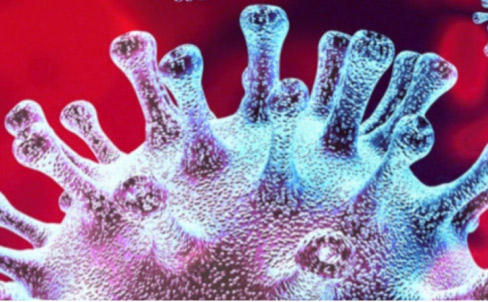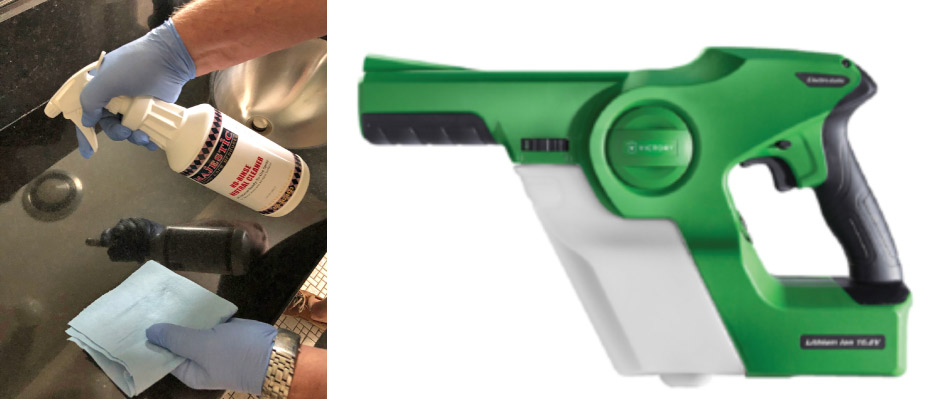Stone Restoration and Maintenance Corner: Sanitizing & Disinfecting Surfaces
Bob Murrell
M3 Technologies
Photos by Bob Murrell
 |
|
This is an image I'm sure we’re all tired of seeing: the spiky, sinister face of the Coronavirus. This article answers some pressing question on how stone and restoration pros can fight back. |
How do you properly clean food preparation and other contact surfaces? Do you need specific sanitizers and disinfectants? Just so you know, I am writing this article in mid-March, at the height of the outbreak, and do not know what the situation will be like by the time May arrives.
First, let’s discuss what some of the associated terms actually imply, according to the cdc.gov/coronavirus/2019 website. Based on what is currently known about the COVID-19 and other similar coronaviruses that cause SARS and MERS, they are typically spread from person-to-person, most frequently among close contacts (within about 6 feet). This type of transmission would normally occur via respiratory droplets (atomized from coughing or sneezing).
As of mid-March, I don’t believe that transmission from contaminated surfaces has been completely documented. However, it is known that these viruses can remain viable for hours to days on surfaces, depending on the degree of soiling and moisture. Knowing human behavioral patterns, we can assume that people who work around and come in contact with these surfaces will, invariably touch their eyes, mouth, or nose, at some point. Of course this could allow entry into the body at these vulnerable locations. So cleaning followed by disinfecting is a best practice measure for the prevention and spread of COVID-19 and other viral and bacterial infections.
Cleaning refers to the removal of dirt, impurities, and germs from surfaces. Cleaning alone does not kill germs but by removing the vast majority of them, lowers their numbers and the risk of spreading infection. So, you see that simply keeping surfaces clean (meaning free from soiling and moisture), we can reduce the chances of contracting the novel COVID-19 as well as other respiratory illnesses in households and community settings.
Disinfecting refers to the use of chemicals to kill germs on surfaces. This process does not necessarily clean dirty surfaces or remove germs, but instead kills germs on surfaces after they have been properly cleaned. Of course this step would also lower the risk of spreading infection.
For general cleaning and disinfecting of stone, terrazzo, or tile surfaces, wear disposable gloves and other PPE, based on your particular application. Gloves should be discarded in an appropriate method (labeled plastic bags) after each cleaning. I recommend using either the Majestic No-Rinse Neutral Cleaner or the Majestic Stone Plus which is also a neutral cleaner. You can use diluted, per the instructions, or increase the concentration based on the degree of soiling. Either product will help clean most any surface that is safe for water. Remember that just keeping surfaces clean will go a long way to keeping the microbe count low.
 |
|
Above, Left: Majestic No-Rinse Neutral Cleaner is an excellent general cleaner for all stone surfaces prior to disinfecting, and to routinely keep clean. Don't forget the gloves whether you are disinfecting your own countertops or those of a client. Above, Right: An electrostatic sprayer reduces the droplet size and imparts an electrostatic charge on the solution droplets so they will cover an area more efficiently, and lengthen the contact time with the disinfectant. |
Actual disinfecting requires the appropriate chemical agent to kill the microbes, in this case COVID-19. At M3 Technologies Inc. we have access to a stone safe product made by one of our production facilities. It is called Surface TB Hard Surface Disinfectant, contains ammonium chloride, and is EPA registered. This product has demonstrated effectiveness against viruses similar to coronavirus (COVID-19) on hard surfaces, when used in accordance with the directions and CDC guidelines. It comes in a ready-to-use formula and is sprayed on the cleaned surface and allowed to dwell for several minutes. After the required dwell time, wipe the surface back down with a clean cloth and either of the Majestic products above.
You can use plain household bleach at 4 teaspoons of bleach per quart of water or 1/3 cup of bleach per gallon of water. Of course, this may harm surrounding surfaces, so be very careful if you go this route. I suggest a product that is approved for stone and masonry surfaces that does not negatively affect the surrounding surface areas.
You can use simple pump-up sprayers but some are using ULV sprayers (foggers) and electrostatic sprayers for commercial applications as they are much more conducive to larger areas. These last two types of equipment are basically made to reduce the droplet size and or impart an electrostatic charge on the droplet so that they will cover an area more efficiently and lengthen the contact time (thereby improving efficacy) with the disinfectant.
As I type, our office in Cohasset, MA, is empty and the employees are now under a stay-at-home order by Governor Charlie Baker. My state of Tennessee has enacted the same basic order. A flattening of the curve is the goal, as I understand it. This is to help impede the spread of the virus and keep the healthcare industry from being overwhelmed.
We are working and processing orders remotely from home and have a person who lives nearby the office who will come in for a few hours each day to box and ready orders for shipping. We are very fortunate in this regard.
White House and Senate leaders seem to have reached a deal on a massive $2 trillion coronavirus relief bill for workers and businesses.
The unprecedented rescue package would give direct payments to most Americans, expand unemployment benefits, and provide a $367 billion program for small businesses to keep making payroll while workers are forced to stay home.
As the President has said, we can’t let the prophylaxis (cure) be worse than the virus, meaning that the flailing economy could be a bigger problem in the end. I am definitely feeling the pain as I watch my life savings dwindle. I do however have confidence in America and know that we will come out stronger than before. Most Americans are doing what is required and we will get through this. Going back to work by Easter certainly sounds great, but whatever it takes, we will persevere.
In the meantime, practice social distancing, wash your hands, keep frequently touched surfaces clean and disinfected, stay at home, and stay current with both the Administration’s and CDC’s guidelines so we can put this COVID-19 behind us.
As always, I recommend submitting a test area to confirm both the results and the procedure prior to starting a stone or hard surface restoration or maintenance project. Also, the best way to help ensure success is by partnering with a good distributor, like Braxton-Bragg, that knows the business. They can help with technical support, product purchase decisions, logistics, and other pertinent project information.
I pray that everyone stays safe and healthy.
Bob Murrell has worked in the natural stone industry for over 40 years and is well known for his expertise in natural stone, tile and decorative concrete restoration and maintenance. He helped develop some of the main products and processes which revolutionized the industry, and is currently the Director of Operations for M3 Technologies.